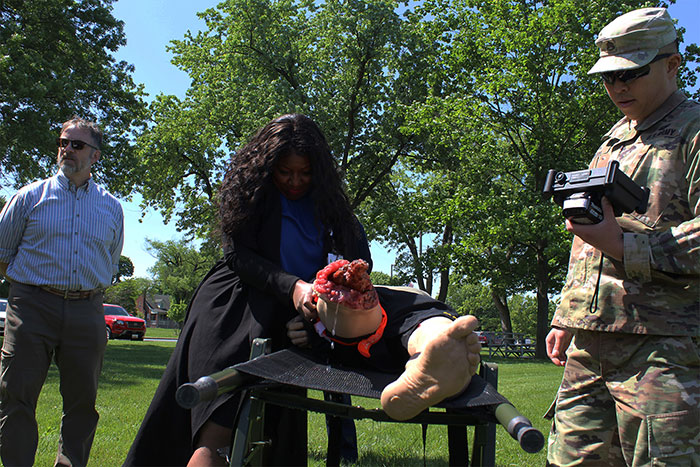'National Stop the Bleed Day' Event Teaches Simple, Lifesaving Skills

The U.S. Army Medical Research and Development Command held its third annual National STOP THE BLEED® Day event at Fort Detrick on May 25. The awareness event, which featured remarks from command leadership and presentations from MRDC research programs, was designed to teach the Fort Detrick community how to properly respond to traumatic bleeding emergencies in everyday situations.
In all, more than 50 attendees from across the installation received hands-on instruction in basic wound packing techniques and proper tourniquet application from MRDC Service Members and Fort Detrick medical training staff.
"When we talk about combat situations, we're talking about stopping the bleed as the number one way to increase the chances of a casualty surviving," said Brig. Gen. Tony McQueen, Commanding General of MRDC and Fort Detrick, who kicked-off the program with remarks focusing on the importance of translating military medical science to the U.S. home front. "These skills are important both as a function of the military profession but also for civilians in their homes and in their communities."
The STOP THE BLEED® campaign was initially developed at MRDC's Combat Casualty Care Research Program in 2015 as part of a cooperative effort with the U.S. National Security Council and the American College of Surgeons. The goal of the campaign is to strengthen national resiliency by empowering American citizens with the skills required to help provide aid to victims of traumatic bleeding. STOP THE BLEED® focuses chiefly on the use of tourniquets, modern versions of which have been both developed by the military and used by Warfighters in innumerable combat scenarios. Currently, traumatic bleeding following injury is the leading cause of death for Americans from one to 46 years of age.
"It's helpful to learn these skills because it's empowering in so many ways," said Robin Walker, a health scientist manager at MRDC's Congressionally Directed Medical Research Programs. Walker, who attended the event for the second consecutive year, recently had the opportunity to use her bleeding control skills at an outdoor gathering when a family member sustained a large puncture wound after stepping on a piece of metal. "Everybody was worried, but I was the only one who knew how to help," said Walker, who notes she packed the wound with gauze and wrapped it with tape before the child was sent to the hospital.

In that same manner, the training portion of the event allowed participants to practice tourniquet application techniques on electronic, life-like manikins – some of which were, in turn, connected to a water supply to simulate the sizable amount of blood associated with a bleeding emergency. Training staff routinely preached the importance of finding the source of a wound early, then using clean gauze to insert into said wound and then, if possible, placing pressure on the wound to slow overall blood loss. As a rule, tourniquets should always be placed two-to-three inches above the wound, closest to the heart.
"This training is awesome – I wish more people from my office were here," said Steven Davanzo, a contract specialist at MRDC's Medical Research Acquisition Activity, attending his first-ever National STOP THE BLEED® Day event. "For some reason, I was under the impression that the military was moving away from using tourniquets. I can see now how important they are."
In addition to the training portion of the event, representatives from both CCCRP and MRDC's Medical Materiel Development Activity were on-site to display various bleeding control products from their respective acquisition efforts. Representatives from the National Museum of Civil War Medicine, located in downtown Frederick, also attended the event to provide a historical perspective of bleeding control products and medical care in general.
"With this program, we're not asking you to carry any special tools – instead, we're trying to equip you with simple knowledge; knowledge that doesn't cost anything," said Austin Langdon, a former flight medic and current assistant program manager at USAMMDA, who delivered remarks during the event. "And best of all, you can use this knowledge for the rest of your life."
Since its launch, the STOP THE BLEED® campaign has been licensed to more than 460 public and private entities across the globe, including partnerships with various U.S. state and municipal governments, local and national hospital systems, community groups, police and fire departments and professional sports teams, among other organizations.
To access virtual STOP THE BLEED® training sessions developed by the American College of Surgeons, a key campaign partner, visit: stopthebleed.org/training/online-course/. For information about the campaign itself and the many ways to get involved, go to stopthebleedproject.org.














